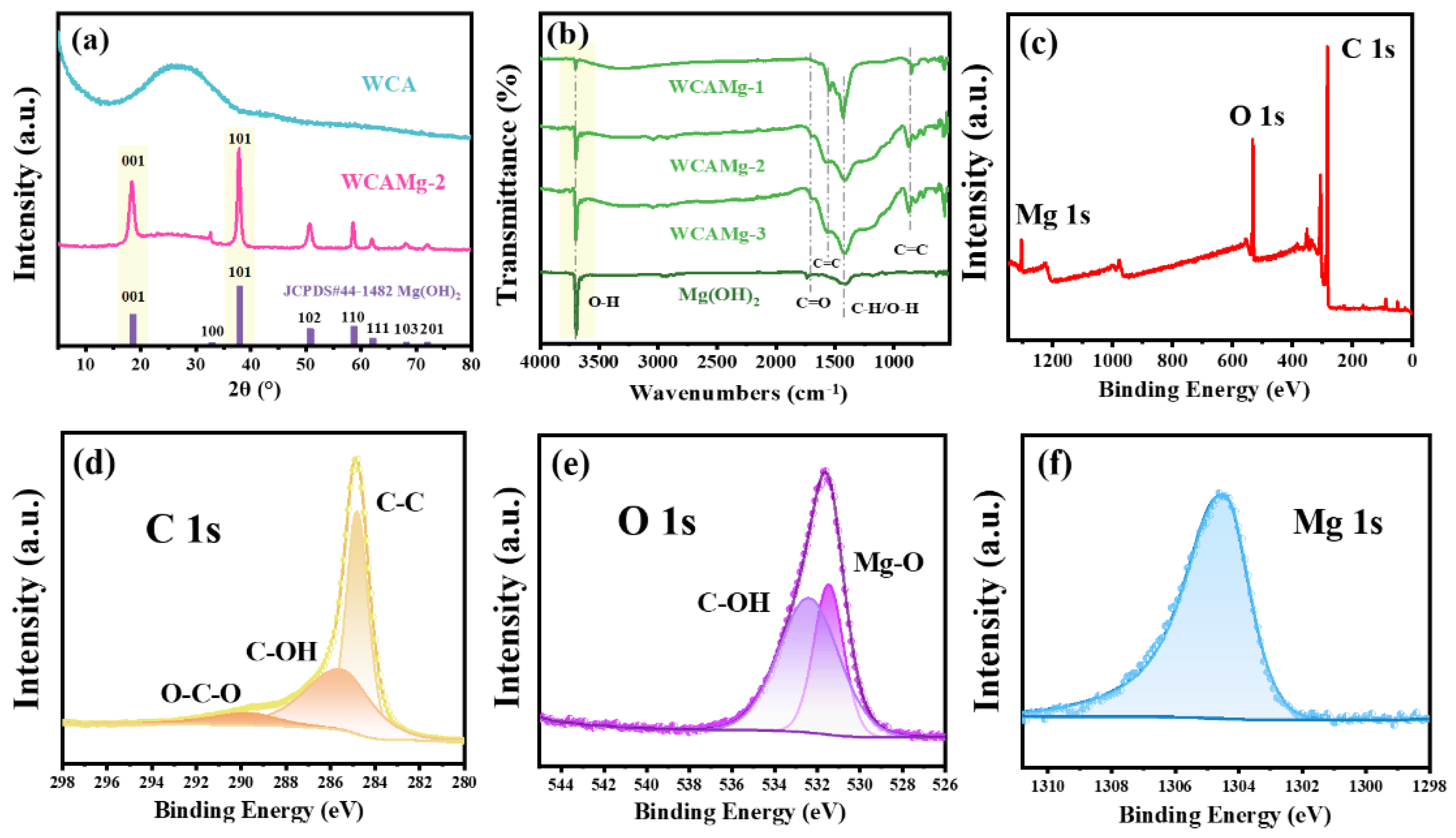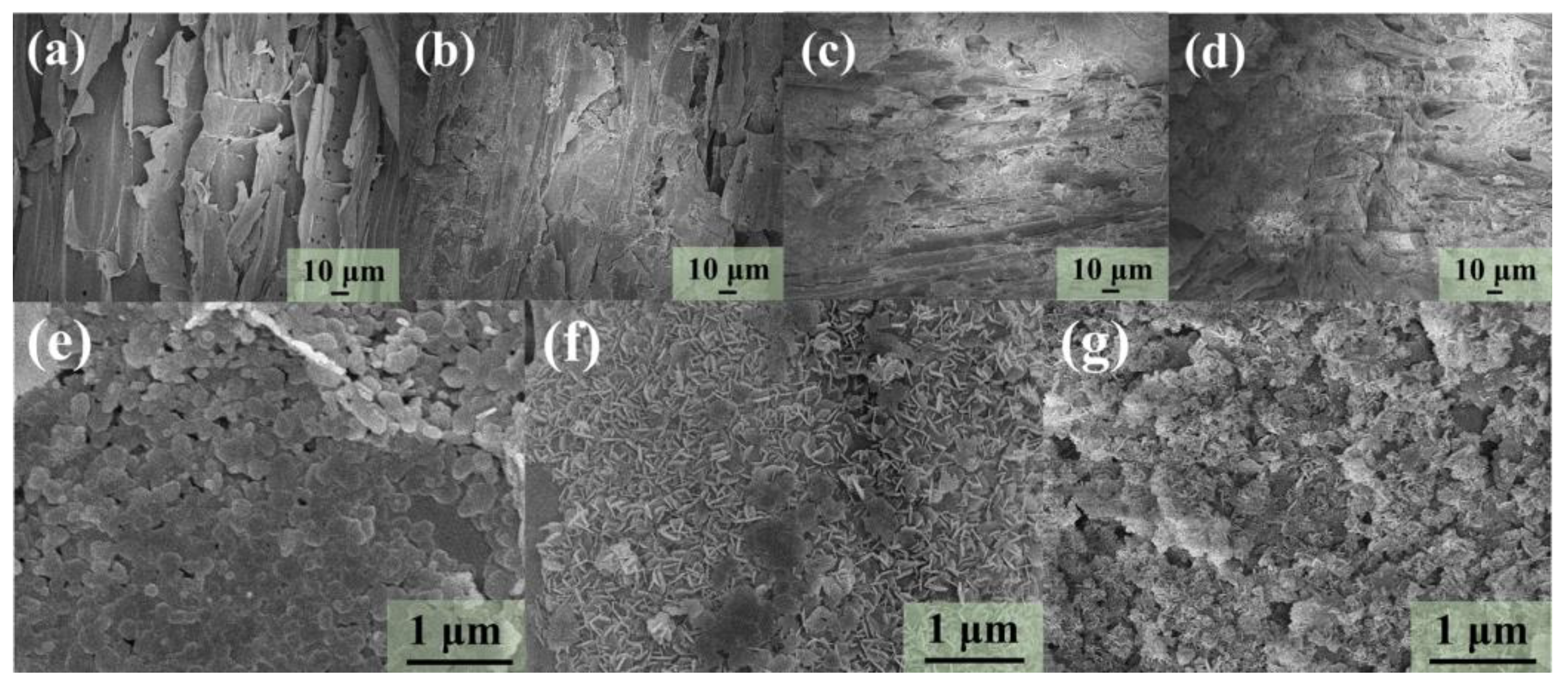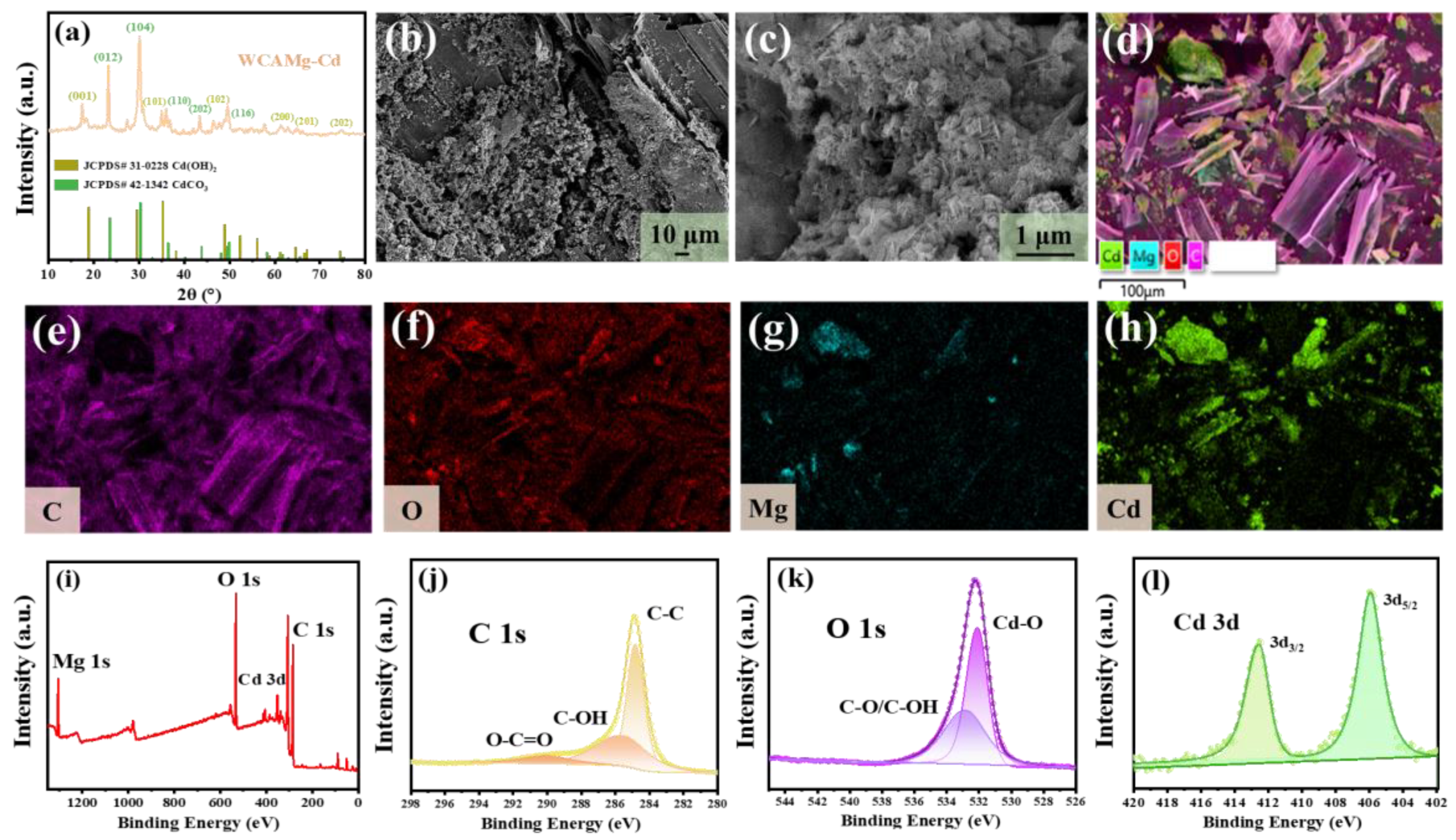Fabrication of Wood-Derived Carbon Aerogel/Mg(OH)2 Bio-Composite and Its High Performance for Adsorption and Separation of Cadmium Ions
Abstract
1. Introduction
2. Experimental
2.1. Materials and Chemicals
2.2. Preparation of WCA
2.3. Preparation of WCAMg
2.4. Adsorption Experiments
2.5. Characterizations
3. Results and Discussion
3.1. Structure and Morphology of WCAMg
3.2. Absorption Performance
3.3. Adsorption Mechanism
3.4. Competitive Ion Interference Effects and Environmental Performance in Natural Water
4. Conclusions
Author Contributions
Funding
Data Availability Statement
Acknowledgments
Conflicts of Interest
References
- Piwowarska, D.; Kiedrzyńska, E.; Jaszczyszyn, K. A global perspective on the nature and fate of heavy metals polluting water ecosystems, and their impact and remediation. Crit. Rev. Environ. Sci. Technol. 2024, 54, 1436–1458. [Google Scholar] [CrossRef]
- Liu, K.; Guan, X.; Li, C.; Zhao, K.; Yang, X.; Fu, R.; Li, Y.; Yu, F. Global perspectives and future research directions for the phytoremediation of heavy metal-contaminated soil: A knowledge mapping analysis from 2001 to 2020. Front. Environ. Sci. Eng. 2021, 16, 73. [Google Scholar] [CrossRef]
- Rahman, M.M.; Karim, M.R.; Alharbi, H.F.; Aldokhayel, B.; Uzzaman, T.; Zahir, H. Cadmium Selenide Quantum Dots for Solar Cell Applications: A Review. Chem. Asian. J. 2021, 16, 902–921. [Google Scholar] [CrossRef] [PubMed]
- Mavazzan, A.; Mendhe, A.C.; Bayannavar, P.K.; Sankapal, B.R.; Kamble, R.R.; Madar, S.F.; KM, M.P.; Bheemayya, L. Design of Metal Free Fluorescent Pyridine Dyes Anchored on Cadmium Sulfide Nanowires: Optical, Electrochemical and Photovoltaic Applications. J. Fluoresc. 2023, 34, 2405–2414. [Google Scholar] [CrossRef]
- Cirovic, A.; Denic, A.; Clarke, B.L.; Vassallo, R.; Cirovic, A.; Landry, G.M. A hypoxia-driven occurrence of chronic kidney disease and osteoporosis in COPD individuals: New insights into environmental cadmium exposure. Toxicology 2022, 482, 153355–153364. [Google Scholar] [CrossRef]
- Zieliński, J.; Huculak-Mączka, M.; Kaniewski, M.; Nieweś, D.; Hoffmann, K.; Hoffmann, J. Kinetic modelling of cadmium removal from wet phosphoric acid by precipitation method. Hydrometallurgy 2019, 190, 105157–105163. [Google Scholar] [CrossRef]
- Liu, S.; Yang, S.; Zhang, X.; Luo, T.; Chen, Y. Removal of cadmium and arsenic from Cd-As-Pb-bearing dust based on peroxide leaching and coprecipitation. Hydrometallurgy 2022, 209, 105839–105851. [Google Scholar] [CrossRef]
- Dabrowski, A.; Hubicki, Z.; Podkościelny, P.; Robens, E. Selective removal of the heavy metal ions from waters and industrial wastewaters by ion-exchange method. Chemosphere 2004, 56, 91–106. [Google Scholar] [CrossRef]
- Elfeghe, S.; Anwar, S.; Zhang, Y. Adsorption and removal studies of cadmium ion onto sulphonic/phosphonic acid functionalization resins. Can. J. Chem. Eng. 2022, 100, 3006–3014. [Google Scholar] [CrossRef]
- Xiang, H.; Min, X.; Tang, C.-J.; Sillanpää, M.; Zhao, F. Recent advances in membrane filtration for heavy metal removal from wastewater: A mini review. J. Water Process Eng. 2022, 49, 103023–103037. [Google Scholar] [CrossRef]
- Maqbool, A.; Shahid, A.; Jahan, Z.; Bilal Khan Niazi, M.; Ali Inam, M.; Tawfeek, A.M.; Kamel, E.M.; Saeed Akhtar, M. Development of ZnO-GO-NiO membrane for removal of lead and cadmium heavy metal ions from wastewater. Chemosphere 2023, 338, 139622–139639. [Google Scholar] [CrossRef]
- Ma, F.; Zhao, H.; Zheng, X.; Zhao, B.; Diao, J.; Jiang, Y. Enhanced adsorption of cadmium from aqueous solution by amino modification biochar and its adsorption mechanism insight. J. Environ. Chem. Eng. 2023, 11, 109747–109758. [Google Scholar] [CrossRef]
- Liu, Z.; Li, X.; Zhan, P.; Hu, F.; Ye, X. Removal of cadmium and copper from water by a magnetic adsorbent of PFM: Adsorption performance and micro-structural morphology. Sep. Purif. Technol. 2018, 206, 199–207. [Google Scholar] [CrossRef]
- Tan, I.A.W.; Chan, J.C.; Hameed, B.H.; Lim, L.L.P. Adsorption behavior of cadmium ions onto phosphoric acid-impregnated microwave-induced mesoporous activated carbon. J. Water Process Eng. 2016, 14, 60–70. [Google Scholar] [CrossRef]
- Sufian, J.; Babaakbari Sari, M.; Marchelli, F.; Fiori, L.; Avanes, A.; Moradi, S. An Analysis of the Factors Influencing Cadmium Removal in Aquatic Environments by Chlorella vulgaris-Derived Solids. J. Carbon Res. 2023, 10, 2. [Google Scholar] [CrossRef]
- Tolkou, A.K.; Maroulas, K.N.; Theologis, D.; Katsoyiannis, I.A.; Kyzas, G.Z. Comparison of Modified Peels: Natural Peels or Peels-Based Activated Carbons for the Removal of Several Pollutants Found in Wastewaters. J. Carbon Res. 2024, 10, 2. [Google Scholar] [CrossRef]
- Mulla, B.; Ioannou, K.; Kotanidis, G.; Ioannidis, I.; Constantinides, G.; Baker, M.; Hinder, S.; Mitterer, C.; Pashalidis, I.; Kostoglou, N.; et al. Removal of Crystal Violet Dye from Aqueous Solutions through Adsorption onto Activated Carbon Fabrics. J. Carbon Res. 2024, 10, 19. [Google Scholar] [CrossRef]
- Xu, H.; Ou, Z.; Li, W.; Hu, T.; Zhang, Y.; Xu, H.; Wang, J.; Li, Y. Cadmium(II) adsorption by recyclable Zeolite-Loaded Hydrogel: Extension to the removal of Cadmium(II) from contaminated soil. Chem. Eng. J. 2024, 492, 151842–151855. [Google Scholar] [CrossRef]
- Perfecto Barragán, P.; Guadalupe Macedo, M.M.; Olguín, M.T. Cadmium sorption by sodium and thiourea-modified zeolite-rich tuffs. J. Environ. Sci. 2017, 52, 39–48. [Google Scholar] [CrossRef]
- Xu, S.; Xing, Y.; Liu, S.; Luo, X.; Chen, W.; Huang, Q. Co-effect of minerals and Cd(II) promoted the formation of bacterial biofilm and consequently enhanced the sorption of Cd(II). Environ. Pollut. 2020, 258, 113774–113783. [Google Scholar] [CrossRef]
- Otunola, B.O.; Ololade, O.O. A review on the application of clay minerals as heavy metal adsorbents for remediation purposes. Environ. Technol. Innov. 2020, 18, 100692–100706. [Google Scholar] [CrossRef]
- Xu, C.; Wang, H.; Shang, Y.; Li, B.; Yu, D.; Wang, Y. Highly efficient Cd(Ⅱ) removal using 3D N-doped carbon derived from MOFs: Performance and mechanisms. J. Hazard. Mater. 2022, 436, 129149–129161. [Google Scholar] [CrossRef] [PubMed]
- Wei, S.; Huang, S.; Zhou, J.; Xiao, C.; Cao, J.; Xiao, J.; Xie, C. Magnetic Carbon Porous Polymer Prepared from a New Suspended Emulsion for the Absorption of Heavy Metal Ions. Polymers 2025, 3, 17–33. [Google Scholar] [CrossRef] [PubMed]
- Dang, A.; Liu, X.; Wang, Y.; Liu, Y.; Cheng, T.; Zada, A.; Ye, F.; Deng, W.; Sun, Y.; Zhao, T.; et al. High-efficient adsorption for versatile adsorbates by elastic reduced graphene oxide/Fe3O4 magnetic aerogels mediated by carbon nanotubes. J. Hazard. Mater. 2023, 457, 131846–131857. [Google Scholar] [CrossRef]
- Zhang, Y.; Wu, L.; Deng, H.; Qiao, N.; Zhang, D.; Lin, H.; Chen, Y. Modified graphene oxide composite aerogels for enhanced adsorption behavior to heavy metal ions. J. Environ. Chem. Eng. 2021, 9, 106008–106018. [Google Scholar] [CrossRef]
- Li, S.C.; Hu, B.C.; Ding, Y.W.; Liang, H.W.; Li, C.; Yu, Z.Y.; Wu, Z.Y.; Chen, W.S.; Yu, S.H. Wood-Derived Ultrathin Carbon Nanofiber Aerogels. Angew. Chem. Int. Ed. 2018, 57, 7085–7090. [Google Scholar] [CrossRef]
- Chen, Z.; Zhuo, H.; Hu, Y.; Lai, H.; Liu, L.; Zhong, L.; Peng, X. Wood-Derived Lightweight and Elastic Carbon Aerogel for Pressure Sensing and Energy Storage. Adv. Funct. Mater. 2020, 30, 1910292. [Google Scholar] [CrossRef]
- Xiong, C.; Fan, X.; Xiong, Q.; Zhang, Y.; Su, Y. Double hydrogen bonding force improves the performance of composite phase change materials by improving the carbon skeleton of wood aerogel. J. Energy Storage 2025, 114, 115752–115761. [Google Scholar] [CrossRef]
- Liang, C.; Qiu, H.; Song, P.; Shi, X.; Kong, J.; Gu, J. Ultra-light MXene aerogel/wood-derived porous carbon composites with wall-like “mortar/brick” structures for electromagnetic interference shielding. Sci. Bull. 2020, 65, 616–622. [Google Scholar] [CrossRef]
- Xu, K.; Jiao, Y.; Li, J.; Xiao, H.; Fu, Q. FeP nanoparticle embedded in N,P-doped 3D porous wood-derived carbon aerogel for oxygen reduction reaction. Carbon 2024, 228, 119408–119416. [Google Scholar] [CrossRef]
- Liu, Z.; Liu, T.; Dong, H.; Yang, B.; Li, X.; Li, X.; Wu, Y.; Xu, K. Diatom-Inspired Nanoscale Heterogeneous Assembly Strategy for Constructing Thermal Insulating Wood-Based Aerogels with Exceptional Strength, Resilience, Degradability, and Flame Retardancy. ACS Nano 2025, 19, 6826–6839. [Google Scholar] [CrossRef] [PubMed]
- Yu, Y.; Wei, L.; Pang, Z.; Wu, J.; Dong, Y.; Pan, X.; Hu, J.; Qu, J.; Li, J.; Tian, D.; et al. Multifunctional Wood Composite Aerogel with Integrated Radiant Cooling and Fog–Water Harvesting for All-Day Building Energy Conservation. Adv. Funct. Mater. 2024, 35, 2414590–2414601. [Google Scholar] [CrossRef]
- García-Zubiri, I.X.; González-Gaitano, G.; Isasi, J.R. Sorption models in cyclodextrin polymers: Langmuir, Freundlich, and a dual-mode approach. J. Colloid Interface Sci. 2009, 337, 11–18. [Google Scholar] [CrossRef]
- Ryszko, U.; Rusek, P.; Kołodyńska, D. Transforming industrial processes: Effective removal of Cd(II) ions from wet phosphoric acid streams. Chem. Eng. J. 2025, 505, 159696–159713. [Google Scholar] [CrossRef]
- Zhao, J.; Yang, S.; Bi, C.; Peng, C.; Wang, Y.; Li, Y.; Tao, E. Modulation of ciprofloxacin adsorption conjugation effect by specific conformation of manganese-nitrogen co-doped biochar and its mechanistic study. Sep. Purif. Technol. 2025, 132304–132315. [Google Scholar] [CrossRef]
- Dai, H.; Li, N.; Cui, Y.; Gao, W.; Peng, X.; Peng, W.; Si, H.; Mu, L.; Shi, Y.; Cheng, Z.; et al. Indispensable Synergy between C=C and C=O Sites in Biochar for Peroxomonosulfate Activation and Sulfamethoxazole Degradation. ACS ES&T Eng. 2024, 4, 2888–2897. [Google Scholar] [CrossRef]
- Zhao, N.-D.; Wang, Y.; Zou, X.-H.; Yin, W.-M.; Wang, X.-Y.; Guo, Y.-R.; Pan, Q.-J. Fabrication of cellulose@Mg(OH)2 composite filter via interfacial bonding and its trapping effect for heavy metal ions. Chem. Eng. J. 2021, 426, 130812–130825. [Google Scholar] [CrossRef]
- Li, Y.; Zhou, M.; Waterhouse, G.I.N.; Sun, J.; Shi, W.; Ai, S. Efficient removal of cadmium ions from water by adsorption on a magnetic carbon aerogel. Environ. Sci. Pollut. Res. 2021, 28, 5149–5157. [Google Scholar] [CrossRef]
- Jing, W.; Yang, C.; Lin, X.; Tang, M.; Lian, D.; Yu, Y.; Liu, D. MnFe2O4-loaded bamboo pulp carbon-based aerogel composite: Synthesis, characterization and adsorption behavior study for heavy metals removal. RSC Adv. 2024, 14, 39995–40005. [Google Scholar] [CrossRef]
- Yuan, M.; Liu, D.; Liu, W.; Song, Z.; Shang, S.; Wang, Z.; Ren, J.; Cui, S. Graphene oxide/polydopamine modified montmorillonite/carboxymethyl chitosan composite aerogel for efficient removal of Pb2+, Cu2+, and Cd2+: Adsorption behavior, mechanism and DFT study. Sep. Purif. Technol. 2024, 339, 126585. [Google Scholar] [CrossRef]
- GB 8978-1996; Integrated Wastewater Discharge Standard. State Environmental Protection Administration (SEPA): Beijing, China, 1996.
- Tran, H.N.; You, S.-J.; Hosseini-Bandegharaei, A.; Chao, H.-P. Mistakes and inconsistencies regarding adsorption of contaminants from aqueous solutions: A critical review. Water Res. 2017, 120, 88–116. [Google Scholar] [CrossRef] [PubMed]
- Li, X.; Shuai, K.; Zhang, Y.; Jiao, G.; Zhou, H.; She, D. Removal of Cd2+ from wastewater to form a three-dimensional fiber network using Si-Mg doped industrial lignin-based carbon materials. Int. J. Biol. Macromol. 2023, 229, 62–69. [Google Scholar] [CrossRef] [PubMed]
- Cai, Q.; Xu, M.; Ma, J.; Zhang, X.; Yang, G.; Long, L.; Chen, C.; Wu, J.; Song, C.; Xiao, Y. Improvement of cadmium immobilization in contaminated paddy soil by using ureolytic bacteria and rice straw. Sci. Total Environ. 2023, 874, 162594–162603. [Google Scholar] [CrossRef] [PubMed]
- Singh, N.; Charan, S.; Patil, K.R.; Viswanath, A.K.; Khanna, P.K. Unusual formation of nano-particles of CdO and Cd(OH)2 from the reaction of dimethyl cadmium with DMF. Mater. Lett. 2006, 60, 3492–3498. [Google Scholar] [CrossRef]
- Li, J.; Chen, M.; Yang, X.; Zhang, L. Effect and mechanisms of soil functional groups in bacterial-enhanced cadmium contaminated soil phytoremediation. Environ. Technol. Innov. 2024, 33, 103531–103545. [Google Scholar] [CrossRef]
- Wang, X.-Y.; Hao, Y.; Zhao, H.-B.; Guo, Y.-R.; Pan, Q.-J. 2D-layered Mg(OH)2 material adsorbing cellobiose via interfacial chemical coupling and its applications in handling toxic Cd2+ and UO22+ ions. Chemosphere 2021, 279, 130617–130627. [Google Scholar] [CrossRef]






| Carbon Aerogel Materials | Cd2+Adsorption Capacity (mg g−1) | References |
|---|---|---|
| WCAMg | 351.1 | This study |
| MCA (Fe3O4) | 143.88 | [38] |
| SA/GO-βCD | 174.85 | [25] |
| rGO/Fe3O4/CNTs | 67.96 | [24] |
| MCA (MnFe2O4) | 73.63 | [39] |
| GO/PDA-MMT/CMCS | 317.46 | [40] |
| PFO Model | PSO Model | ||||||
|---|---|---|---|---|---|---|---|
| C0 (mg L−1) | qe, exp (mg g−1) | qe, cal (mg g−1) | k1 (h−1) | R2 | qe, cal (mg g−1) | k2 (g mg−1 h−1) | R2 |
| 50 | 110.9 | 107.8 | 0.2419 | 0.9773 | 118.5 | 0.002890 | 0.9965 |
| 100 | 223.6 | 218.5 | 0.1104 | 0.9882 | 256.5 | 0.0004935 | 0.9968 |
| 200 | 351.1 | 349.4 | 0.0691 | 0.9955 | 445.5 | 0.0001457 | 0.9984 |
| Phase 1 | Phase 2 | Phase 3 | |||||||
|---|---|---|---|---|---|---|---|---|---|
| C0 (mg L−1) | R12 | C1 (mg g−1) | Kp1 (mg g−1 h−1/2) | R22 | C2 (mg g−1) | Kp2 (mg g−1 h−1/2) | R32 | C3 (mg g−1) | Kp3 (mg g−1 h−1/2) |
| 50 | 0.9973 | −3.069 | 35.57 | 0.9767 | 36.99 | 17.25 | 1 | 110.9 | 0 |
| 100 | 0.9991 | −10.67 | 48.13 | 0.9778 | 67.36 | 24.89 | 1 | 223.6 | 0 |
| 200 | 0.9951 | −21.81 | 59.02 | 0.9987 | −5.745 | 56.81 | 0.9580 | 189.0 | 21.24 |
| Langmuir Model | Freundlich Model | |||||
|---|---|---|---|---|---|---|
| qmax (mg g−1) | KL (L g−1) | R2 | n | KF (mg g−1 L1/n mg−1/n) | R2 | |
| WCAMg-2 | 352.5 | 8.675 | 0.9994 | 0.05020 | 261.5 | 0.7417 |
Disclaimer/Publisher’s Note: The statements, opinions and data contained in all publications are solely those of the individual author(s) and contributor(s) and not of MDPI and/or the editor(s). MDPI and/or the editor(s) disclaim responsibility for any injury to people or property resulting from any ideas, methods, instructions or products referred to in the content. |
© 2025 by the authors. Licensee MDPI, Basel, Switzerland. This article is an open access article distributed under the terms and conditions of the Creative Commons Attribution (CC BY) license (https://creativecommons.org/licenses/by/4.0/).
Share and Cite
An, R.; Liu, J.; Ma, H.; Yan, Y.; Guo, Y.; Pan, Q.; Li, S. Fabrication of Wood-Derived Carbon Aerogel/Mg(OH)2 Bio-Composite and Its High Performance for Adsorption and Separation of Cadmium Ions. C 2025, 11, 32. https://doi.org/10.3390/c11020032
An R, Liu J, Ma H, Yan Y, Guo Y, Pan Q, Li S. Fabrication of Wood-Derived Carbon Aerogel/Mg(OH)2 Bio-Composite and Its High Performance for Adsorption and Separation of Cadmium Ions. C. 2025; 11(2):32. https://doi.org/10.3390/c11020032
Chicago/Turabian StyleAn, Ran, Jinyue Liu, Haomiao Ma, Yuqing Yan, Yuanru Guo, Qingjiang Pan, and Shujun Li. 2025. "Fabrication of Wood-Derived Carbon Aerogel/Mg(OH)2 Bio-Composite and Its High Performance for Adsorption and Separation of Cadmium Ions" C 11, no. 2: 32. https://doi.org/10.3390/c11020032
APA StyleAn, R., Liu, J., Ma, H., Yan, Y., Guo, Y., Pan, Q., & Li, S. (2025). Fabrication of Wood-Derived Carbon Aerogel/Mg(OH)2 Bio-Composite and Its High Performance for Adsorption and Separation of Cadmium Ions. C, 11(2), 32. https://doi.org/10.3390/c11020032








